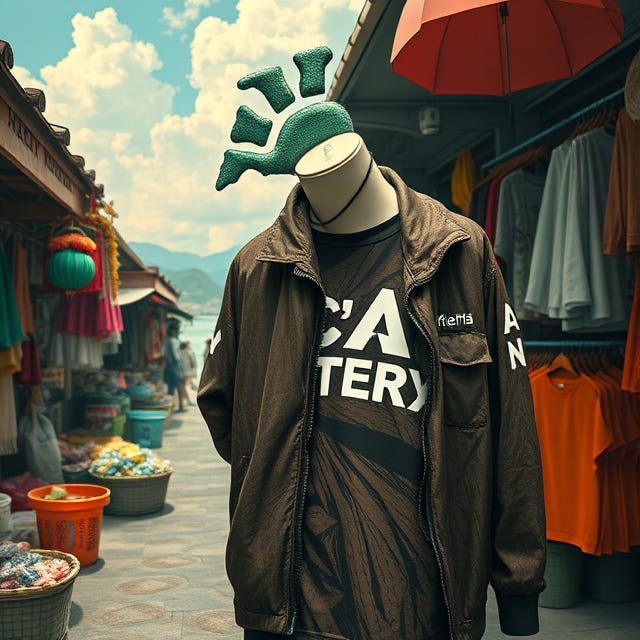Fake goods markets in Vietnam are like Red Light Districts for shopping addicts. Patchwork Patagonia bags wink at you from hooks while Arc’Teryx waterproofs flash their Gore-Tex tags if your glance becomes a stare. You don’t even need to get out your Dong to go inside and cop a feel.
Okay, I don’t want to belabour the metaphor — I’m sure you get the point. But what I’m getting at is the temptation of it all. The North Face jackets look real, they feel real, and they’re about £15-20. You can buy an Arc’Teryx coat for less than 1/10th of the retail price in the U.K.
I can confidently predict readers’ opinions on this subject based on whether they’ve been to Vietnam or not. Those who haven’t seen the fakes here will scoff at the idea of purchasing counterfeit goods, whether they look legitimate or not. There’s a status associated with owning real brands in the U.K. and those who buy fake gear are looked down upon by those who don’t.
For those who have been to Vietnam, however, they will have their heads turned and their minds changed. The near indistinguishability of the fake goods available will make you think twice about buying the same thing at retail in the U.K. Even if you told people at home that your new wardrobe is fake, they wouldn’t know without disclaimer, and they’ll nod with approval when they witness the quality.
The twist in the tale of Vietnamese fakes appears in the mental gymnastics attempted by those buying:
“I think this is actually real.”
“The mafia control the factories and take truckloads of stuff before they open.”
“40% of Nike goods are made in Vietnam, what makes you think these aren’t real?”
I’m not saying none of the clothing, bags, and accessories on sale are real (I kind of am), but what I find most perplexing is our collective desperation to legitimise the purchases as deserving the same respect as though we’d parted with hundreds of pounds for the same thing. I’m not excluding myself from this by the way — I’m just as delusional, rubbing the material of yet another Arc’Teryx coat and thinking “How can a fake be this good?”.
But in reality, we know nothing of the quality of these goods until they’ve been put through their paces. The number of people I encountered while on the Ha Giang loop who were shivering in their North Face coats and cursing holes in Patagonia fleeces was astounding. It seems as though whenever these items are tested in the environments they’re supposedly designed for, they fall short every time. The zip on a pair of Nike shorts I bought in Ho Chi Minh has already broken and the pocket on another threatens to rip every time I slip my phone in there.
So, it’s clear that there is a certain temptation to buy high-quality fakes at extremely low prices. Just walk past any of these shops and they’re filled with Western tourists. The Ha Giang loop was like a U.K. streetwear meet-up minus the immaculate trainers —it seems the willingness to purchase fake clothing doesn’t extend to trainers en masse, which is curious. Despite this temptation, and the evident reality of our readiness to purchase these goods, is it morally acceptable?
This is the question that has been eating at me during my time in Vietnam. I haven’t felt the urge to purchase anything beyond the bare essentials (cheap boxer shorts or socks) or maybe the odd local football shirt, in my entire time on the road. But here I’ve been making excuses as to why I might benefit from a new waterproof, or a running jacket that hasn’t seemed necessary yet and probably won’t as we head into warmer climes. I’ve succeeded in resisting these buys while succumbing to the aforementioned shorts and one Patagonia t-shirt but there are so many ethical questions to be asked about our participation in this growing industry of high-quality fakes.
Is it right to cheat the original brand out of its profits?
Is there exploitation involved at any point in the supply chain?
By haggling with shopowners over prices, are we cheating them out of profits in a race to the bottom?
If the material is poorer than the original, and I have to buy twice, am I simply perpetuating the fast-fashion industry?
I don’t have the answers to these questions, but I find it easier to come to my own conclusion by asking myself one thing, “if these brands are prohibitively expensive at home, then what am I gaining from wearing them here?”. You see, I’m okay with not wearing things I can’t afford. My rationalisation is that I am not what I wear, and my character speaks for so much more than the clothing on my back. So, then, why do I find myself pulled to these expensive brands as soon as they appear affordable? The answer to this lies in our addiction to commercialisation and the symbols associated with these brands.
“Better” brands = More self-respect and desirability among peers.
This very notion makes the purchasing of counterfeit goods seem abhorrent to anyone who stops to think about it for just a few moments. The problem is that there is no dopamine hit associated with this consideration, and certainly no additional respect from peers. If anything, you’d find yourself derided by taking the supposed moral high ground. But if we are anything, we are the decisions we make. And if we stop making decisions based on careful thought and instead just conform to the norm, regardless of the externalities, then I’m not sure we’re worth the skin we’re in.




